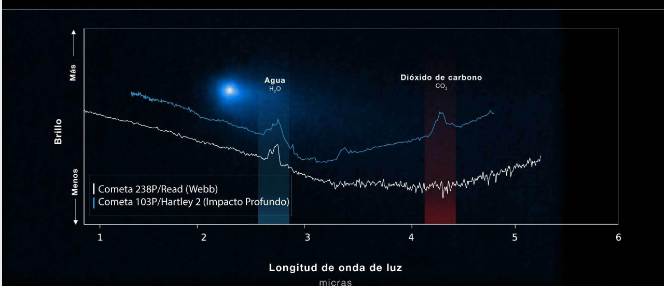NASA’s James Webb Space Telescope has enable another long-awaited scientific breakthrough. This time for solar system scientists studying the origins of Earth’s water abundance. Using Webb’s near-infrared spectrograph (NIRSpec) instrument. A team of astronomers has for the first time confirme the existence of gas – specifically. Water vapour – around a comet in the main asteroid belt. Indicating that primordial solar system water ice may be preserve in that region. However with the successful detection of water comes a new puzzle: unlike other comets, comet 238P/Read had no detectable carbon dioxide.
„Our water-saturated world, teeming with life and, as far as we know, unique in the universe, is something of a mystery: we’re not sure where all this water came from,” said Stefanie Milam, Webb Telescope’s deputy project scientist for planetary science and co-author of the study outlining the finding. „Understanding the history of water distribution in the solar system will help us understand other planetary systems and whether they could be on their way to hosting an Earth-like planet,” she added.
Comet Read is a main-belt comet, an object that resides in the main asteroid belt but periodically displays a halo, or coma, and a comet-like tail. The frozen material that vaporises as comets approach the Sun is what gives these objects their characteristic coma and floating tail, distinguishing them from asteroids. Scientists have long speculate that water ice might be preserve in the warmer asteroid belt inside Jupiter’s orbit. Definitive proof was hard to come by until the advent of the Webb telescope.
In the past, we have seen main-belt objects that have all the characteristics of comets, but only with this precise spectral data from Webb can we say that yes, it is definitely water ice that creates that effect,” explained astronomer Michael Kelley of the University of Maryland, lead author of the study.
The absence of carbon dioxide was a major surprise. Typically, carbon dioxide makes up about 10 percent of a comet’s volatile material that can be easily vaporised by the Sun’s heat. The science team offers two possible explanations for the lack of carbon dioxide. One possibility is that comet Read had carbon dioxide when it formed, but has lost it due to warm temperatures.
„Being in the asteroid belt for a long time could cause this: carbon dioxide vaporises more easily than water ice and would have leaked out over billions of years,” Kelley said. Another option, he said, is that the Read comet would have formed in a particularly warm pocket of the solar system, where carbon dioxide was not available.







